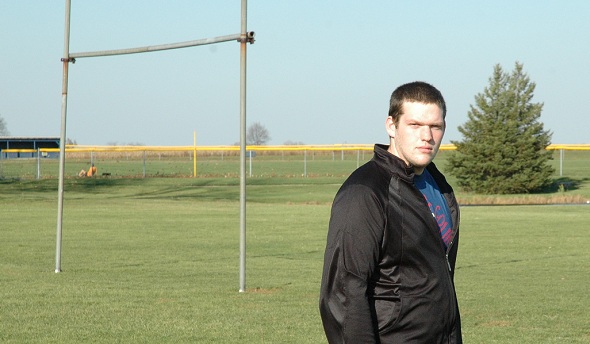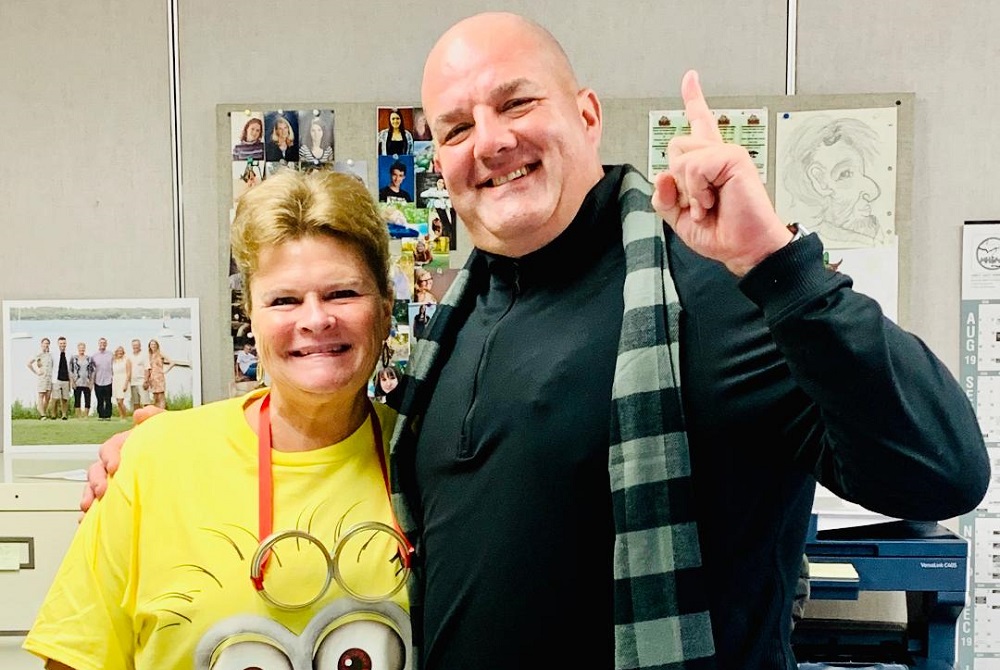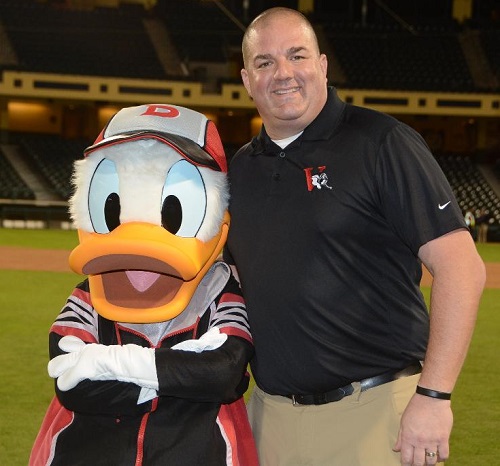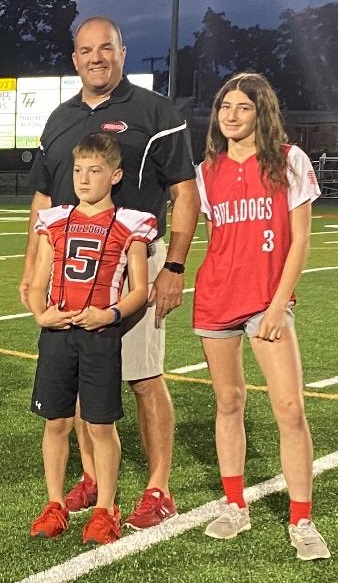
Heartfelt Thanks for a Life Saved
November 13, 2012
By Geoff Kimmerly
Second Half editor
ELSIE – Like many who have played high school football, the practice field will always be more than just another piece of lawn to Ovid-Elsie’s Chris Fowler.
Over his right shoulder, beyond a few of the fields that surround his high school, sits his family’s house. To his left is the finish to the school’s cross country course his younger sister was preparing to run the day his heart stopped beating.
In this spot, on Oct. 9, the 16-year-old Fowler collapsed while he and his teammates ran 40-yard sprints. His heart, for reasons doctors could not explain, went into an irregular rhythm that caused him to go into cardiac arrest.
“It still doesn’t (make sense),” Fowler said two weeks later. “I try to forget it as much as I can. It’s not worth remembering. I don’t want to think about it.”
But the Marauders sophomore will always remember those who brought him back to life that day.
Thanks to the quick, calm response of Ovid-Elsie football coach Travis Long and his staff, and the speedy work of athletic director Sonya Latz to retrieve the school’s AED device, Fowler’s heart was shocked back to life.
Unlike too many national news stories lately of athletes who died far too soon of similar circumstances, this story ends well.
Fowler’s father Dave knows it is because every detail was carried out to perfection. Standing near the cross country finish line, he was there to watch it all.
“Truthfully,” Dave said, “I thought it was the end of my world.”
Trying to remember, trying to forget
Both father and son knew the story of Fennville’s Wes Leonard, who died from sudden cardiac arrest after making the game-winning shot in a basketball game March 3, 2011.
They hadn’t heard of the all-state football and basketball player before that day, but Dave began following the story as it became national news and spurred an effort to have AEDs in every school.
AED stands for automated external defibrillator. The device combats sudden cardiac arrest by detecting an irregular heart beat and delivering a shock that can put the heart back into correct rhythm. Ovid-Elsie High School has two. The first was purchased through the Kimberly Anne Gillary Foundation, which was started after Gillary, a student at Troy Athens, died of sudden cardiac arrest during a water polo game in 2000. The second was donated by alum and former basketball player Daryl Melvin, now a cardiologist in Lansing.
Chris remembers reading about Leonard’s death the day after and thinking there was no way it could happen again to someone like him.
Dave Fowler recounts in his head daily how it nearly did.
The image he can’t get out of his mind is that of Chris’ coaches flipping him over and starting chest compressions.
“It’s just like it was unreal. It was like a bad dream I was waiting to wake up from,” Dave said.
Chris remembers none of it.
He’s a strong student who even before this was considering becoming a doctor. He’s the middle child of three – sister Maria graduated in the spring, and Morgan is in eighth grade. Basketball is Chris’ favorite sport, and he also played soccer growing up – but frequently was carded for running over opponents.
 So logically, in eighth grade, he gave football a try. Two years later, at 6-foot-3 and 265 pounds, Fowler was a starting offensive tackle on the varsity.
So logically, in eighth grade, he gave football a try. Two years later, at 6-foot-3 and 265 pounds, Fowler was a starting offensive tackle on the varsity.
The Marauders’ Oct. 9 practice was dedicated to defense. Fowler took a shot to the ankle and rolled it, and remembers mentioning it to quarterback Jake Helms. That was probably about 25 minutes before the team began its daily conditioning, a set of 20 short sprints run at half to three-quarters speed.
Dave watched his son run while waiting for Morgan’s race to begin. Her mom Amy was at the starting line, and their grandparents also were in attendance, part of a larger crowd because the cross country jamboree included multiple teams from all eight schools in Ovid-Elsie’s league.
And then shock. “I knew what was going on,” Dave said. “But it was denial that I was really seeing what I was seeing.”
Call to quick action
Suddenly, Chris was face down on the ground.
Only moments later, Long and assistant Brad Sutliff were flipping him over. Long, a physical education teacher at the school, began the chest compressions. Another coach blew breaths into Fowler’s lungs.
Dave, perhaps acting on instinct as much as anything, yelled for anyone to find his wife. He took off toward Latz, who also had made her way to the cross country finish area, yelling for her to get the AED.
Word of Fowler's dire situation quickly made its way through the crowd. The Bullock Creek cross country team, surely among many others, began to pray. And Dave will never forget watching Chris’ teammates, standing a short way off, yell at him, “Don’t give up! Keep fighting!”
Latz, in the school’s Mule utility vehicle, raced to the trainer’s room, grabbed the AED and raced back. A parent from another school who is a nurse asked if she could help and took the AED to the coaches, who connected it to Fowler.
The AED gives the user explicit instructions on how to operate it, including where to attach connections and when to step away as to avoid also receiving a shock.
Sutliff was holding Fowler’s head and didn't want to set it down. But he had to – the shock was so strong it lifted Fowler’s body off the ground.
The jolt also reset his heart.
The next thing Fowler remembers, he was in the ambulance on the way to Sparrow Hospital in Lansing, vomiting. And he couldn't see. He flashed his hand in front of his face, trying to find it. It was then that he found out his heart had stopped.
After a night at Sparrow, Fowler was taken to the University of Michigan’s C.S. Mott Hospital, where he spent five days. Fowler went through the battery of tests. No problems were found. The family doesn't have a history of heart trouble. Doctors said there were no blockages.
“They said basically that it’s a miracle. There are no side effects, none whatsoever,” Dave Fowler said. “No heart damage, no organ damage. The neurologist said his brain function is perfect; there’s nothing wrong with it. And they all say that stems from the quick reaction from the coaches. … The doctor said he’s never seen chest compressions done that well.”
Ovid-Elsie has a disaster plan in place for situations like these, but had never had to put it into play for a life-threatening situation as long as Latz has been part of the athletic staff – dating back to her first year coaching in 1989.
It went off without a hitch. The whole process of starting compressions, retrieving and hooking up the AED and restarting Fowler’s heart took maybe a bit more than five minutes.
“The coaching staff is amazing, how smooth and calm everybody kept just to do their jobs. I’m just amazed,” Latz added. “I shouldn't say ‘amazed.’ Because I trust that they are very good. I’m just proud of the way they handled everything.”
She added that Ovid-Elsie’s National Honors Society has asked about raising funds to purchase an AED for a school that doesn't have one.
Many thanks to give
Fowler wears two bracelets he received while at U-M. One reads “Hearts working together,” and the other “And the beat goes on.” He was considering becoming a neurologist some day, but now cardiology seems pretty cool.
 Fowler’s friends don’t ask much about that day. They know he’s trying to block it out of his memory. But others do ask the “ridiculous questions. Like, you know, what did it feel like to be dead?”
Fowler’s friends don’t ask much about that day. They know he’s trying to block it out of his memory. But others do ask the “ridiculous questions. Like, you know, what did it feel like to be dead?”
His response: “I just say I wasn't getting oxygen to my brain, so I don’t remember anything.”
The questions don’t make him angry. It’s easy to figure out quickly that Fowler is the type to let such things just roll off.
When Fowler does hear his story re-told, he feels like it’s about someone else.
But he’s a smart guy, and he’s heard enough doctor talk to understand what’s going on.
The biggest bummer is he can’t play basketball. His career in contact spots is over. That leaves golf, and he might take it up eventually. This winter, he’s going to be on the bench with his varsity teammates and he’ll help with the freshmen team and perhaps Morgan’s eighth-grade team too.
He still sounds like a football player. “It’s a lame scar,” he said of the small cut under the front of his left shoulder. Embedded in a “pocket” under his skin on the left side of his chest is an implantable cardioverter defibrillator – or ICD – meant to automatically shock his heart back into rhythm if it falls out of beat again.
Fowler came back for a football practice before the Marauders season ended, and also for the parents’ night game. He’ll still be part of that program next year too. “The joke around town is I’ll be the offensive coordinator,” Fowler said.
Dave still asks himself the what-ifs of that day. He looks at his family differently. Too many times during the day he pictures those chest compressions. It’s hard for him to leave home, and he doesn't sleep well. And he’s pretty sure Chris is getting tired of his parents peeking into his room at night to make sure all is well.
Perhaps. But Fowler also has never been one to take anything for granted – although that’s another part of what makes this situation tough. He’s always one to show gratitude, but he can’t remember right now all the people he’d like to thank. He’s just doing his best.
“I can’t remember. There are so many people. I saw some people at the football game, and I just walked up and said thank you,” Fowler said. “Because they were there, praying for me or whatever.
“I’m very fortunate. It’s unbelievable.”
Click to see more from the Wes Leonard Heart Team or the Kimberly Anne Gillary Foundation.
NOTE: Chris Fowler's parents Dave and Amy would like to give special thanks to those pictured with their son (in suit and orange shoes) above: athletic director Soni Latz and football coaches Brad Sutliff, Eric Jones, Jeremy Palus, Cody Staley, Travis Long and Dustin Thiel.
PHOTOS: (Top) Chris Fowler stands in the place on Ovid-Elsie's practice field where coaches worked to restart his heart on Oct. 9. (Middle) Fowler, in his game jersey, stands on Ovid-Elsie's football field. (Bottom two photos courtesy of the Fowler family.)

Vicksburg AD Roy Honored Nationally for Service to School Sports
By
Pam Shebest
Special for MHSAA.com
February 15, 2022
VICKSBURG — Accepting an award on a national stage is an impressive feat for any athletic director.
 But it was even more special for Vicksburg AD Mike Roy, who shared that stage with his mentor and good buddy.
But it was even more special for Vicksburg AD Mike Roy, who shared that stage with his mentor and good buddy.
While Roy was presented a Distinguished Service Award from the National Interscholastic Athletic Administrators Association in December, retired AD Mike Garvey was inducted into its Hall of Fame.
“This award from the NIAAA was exceptionally special to me because Mike got inducted the very same night into the NIAAA Hall of Fame,” Roy said.
“To be able to receive that award with someone who means so much to me and has guided me and been so influential in my career was the icing on the top, the cherry.”
Garvey said to be mentioned as Roy’s mentor “is an amazing compliment. When the Hall of Fame asked me to send some photos, I had to have him in one.”
The two men first connected 23 years ago when Garvey left Lawton High School for the AD’s job in Delton. Roy filled the Lawton position.
“Mike took me under his wing,” Roy said. “He introduced me to another great friend, Fred Smith.
“Just a couple guys who are awesome gentlemen who are recognized throughout the country.”
Garvey reflects that admiration.
“Mike Roy has been recognized in Michigan and it’s time the rest of the country knows how great he is.” Garvey said.
“It was wonderful to share the stage with him. He’s a high-energy person who attacks everything with vigor. He gets things done.”
Two years ago, Roy received the MHSAA’s Allen W. Bush for service, prompting a Roy-like comment.
“With my joking, sarcastic system, I said to myself, ‘I must be getting old because I’m starting to get these awards and being recognized for it,’” he said.
“But, really, upon hearing it, you just sit back and are really taken aback and humbled by it.”
Rooted in Paw Paw
Roy started his athletic career in Paw Paw with football, basketball, baseball and track in high school.
After turning down offers from Division III schools, Roy accepted a football scholarship to University of Nevada, Las Vegas, which was an eye-opener.
“I found out very quickly when I got to UNLV to play football that I was no longer the big fish in the pond,” he said. “I was a very small fish in a very big pond.
“Going to UNLV forced me to grow up. Sometimes when reality smacks you in the face, it kind of wakes you up.”
That experience helps him guide high school athletes today.
 “Looking back now, there are some things I wish I had done on the academic side of it,” he said. “I wasn’t a great student; I wasn’t a terrible student. I wish I had done better.
“Looking back now, there are some things I wish I had done on the academic side of it,” he said. “I wasn’t a great student; I wasn’t a terrible student. I wish I had done better.
“My career goal at that time, wishful as it was, was to be an NFL player.”
At UNLV, Roy earned a bachelor’s degree in physical education and health with an endorsement in driver’s education and a master’s in instructional and curricular studies.
Once back in Michigan, Roy coached golf and strength and conditioning at Kalamazoo Valley Community College, taught strength classes at Western Michigan University and was an assistant to Kalamazoo College men’s basketball coach Joe Hacklin.
Roy applied for a job at Vicksburg High School — which he did not get.
Instead, he was hired to replace Garvey at Lawton, also teaching strength and conditioning, and coaching varsity basketball.
Three years later, Roy became AD at Vicksburg, a job he has had for the last 20 years.
Accolades began piling up, including the certified master athletic administrator designation from the NIAAA in 2005, Michigan Interscholastic Athletic Administrator Association (MIAAA) Athletic Director of the Year in 2012, MIAAA president in 2019-20, NIAAA delegate at the National Federation of State High School Associations (NFHS) national conference for 10 years and being named a finalist for National Athletic Director of the Year from the National High School Coaches Association.
At the NHSCA ceremony, Roy said he noticed one of the other finalists.
“One of the guys, when I looked, I said ‘Oh my gosh. He’s been an AD for 45 years.’
“Here I’m sitting with not even half that under my belt, wondering if I’m going to get 45 years in.”
Ever humble, Roy makes a point several times of mentioning that any award he receives is a culmination of efforts from a great support staff.
“I tell people in my joking way, ‘It’s my ugly face that gets the award, but when people come to Vicksburg they meet my ticket-taker or see my game management is on point,” he said.
“I wouldn’t be able to get half this stuff if I didn’t have the athletic secretary (Rhonda VanderKamp) I have. She’s phenomenal.”
VanderKamp, who has worked with Roy all 20 years, said they work well together.
As for sharing in any awards, “I’m honored but truly he deserves those awards,” she said. “We just complement each other.
“I’m so honored when I attend some of the conferences and they go around the room and ask you how many years you’ve been an athletic secretary and how many ADs have you been through. I can say only just one. It’s awesome.”
Showing off a great home
Under Roy, Vicksburg has hosted more than 100 MHSAA postseason events, and he takes pride in the workers and facilities.
“I’ve always been big on the appearance of our facilities,” he said. “Unfortunately, the outside community doesn’t get to see our library. They don’t get to see our science labs and all the other wonderful things we have going on in the building.
“When they come to Vicksburg, they’re drawing their assumptions on how they’re treated when they walk through the gate, how do the facilities look, are the trash cans overflowing, are things broken.”
He said when the MHSAA asks or looks for people to step up and host tournaments, “We have always been willing to do that. I ask our people and they say yes, we want to bring people to Vicksburg and show off our facilities.”
 Roy also implements ideas he hears at various conferences.
Roy also implements ideas he hears at various conferences.
“I always try to network and find out who’s doing something better than I’m doing and borrow that,” he said. “The neat thing about athletic directors in our association is we’re willing to share everything.
“We’re different than coaches who have a secret play or a playbook and don’t want anybody to know those plays.”
He noted that not everyone is cut out to be an athletic director.
“Most think all I do is sit around and eat popcorn, a hot dog and watch contests and how cool that is,” he said, laughing.
He said they do not see the contact with officials and support staff, refilling of concession supplies, setting up transportation to away games, notifying parents of any changes or problems and working on game schedules for next year.
As for non-AD duties, Roy spends time with his two children: Harper, a 5-foot-8 seventh grader whom he coaches on a 12-and-under softball team; and Ryker, a fourth grader involved in football, basketball, wrestling and baseball.
Doing things the right way
Roy said former Gull Lake AD Mike Foster helped craft his philosophy that high school sports are more than just winning.
“To me, in high school educational athletics, we’re here to grow the whole child and just not teach him how to win,” he said.
“I’m hiring my coaches who are going to be the best role models for my kids. We do want to win, because it’s important, but it’s not the ultimate goal for me.”
Speaking of coaches, Roy noted that his mentor is now an employee.
“Funny thing,” he said. “Mike Garvey’s my golf coach here. I always try to surround myself with some talented individuals.”
Garvey said Roy is the only reason he agreed to coach the boys golf team, and he would not consider doing it for anyone else.
“With his coaches, they’re a family and he’s like the patriarch who shows a lot of love and respect,” Garvey said.
***
 Garvey was one of 10 inductees making up the 13th class of the NIAAA Hall of Fame honored in December. Garvey served as an athletic administrator for 24 years through 2018 with stops at Lawton, Delton Kellogg, Otsego and Kalamazoo Hackett Catholic Prep. He received the MHSAA’s Allen W. Bush Award in 2015 and Charles E. Forsythe Award in 2020. He also was an assistant coach on two MHSAA Finals wrestling championship teams and as head coach led Lawton to the Class D title in 1990.
Garvey was one of 10 inductees making up the 13th class of the NIAAA Hall of Fame honored in December. Garvey served as an athletic administrator for 24 years through 2018 with stops at Lawton, Delton Kellogg, Otsego and Kalamazoo Hackett Catholic Prep. He received the MHSAA’s Allen W. Bush Award in 2015 and Charles E. Forsythe Award in 2020. He also was an assistant coach on two MHSAA Finals wrestling championship teams and as head coach led Lawton to the Class D title in 1990.
Garvey has been an active member of both the MIAAA and NIAAA and the Michigan Wrestling Coaches Association, and a member of the faculty for the NIAAA’s Leadership Training Institute while also serving as Michigan’s coordinator for the program. In retirement, he has continued to contribute to school sports in a variety of other ways as well including as a meet manager of the MHSAA’s Team Wrestling Finals at Wings Event Center in Kalamazoo.
Among additional accolades at the state and national levels, Garvey received the NIAAA’s 2016 Distinguished Service Award and the George Lovich State Award of Merit in 2009 from the MIAAA.
 Pam Shebest served as a sportswriter at the Kalamazoo Gazette from 1985-2009 after 11 years part-time with the Gazette while teaching French and English at White Pigeon High School. She can be reached at [email protected] with story ideas for Calhoun, Kalamazoo and Van Buren counties.
Pam Shebest served as a sportswriter at the Kalamazoo Gazette from 1985-2009 after 11 years part-time with the Gazette while teaching French and English at White Pigeon High School. She can be reached at [email protected] with story ideas for Calhoun, Kalamazoo and Van Buren counties.
PHOTOS (Top) Vicksburg athletic director Mike Roy gives much credit to his secretary Rhonda VanderKamp, his assistant during the entirety of his two decades at the school. (Middle) Roy takes a minute to take a photo with Donald Duck during a conference in Orlando, Fla. (Below) Roy and his children Harper and Ryker await the presentation of his MHSAA’s Allen W. Bush Award. (Photos courtesy of Mike Roy.)

